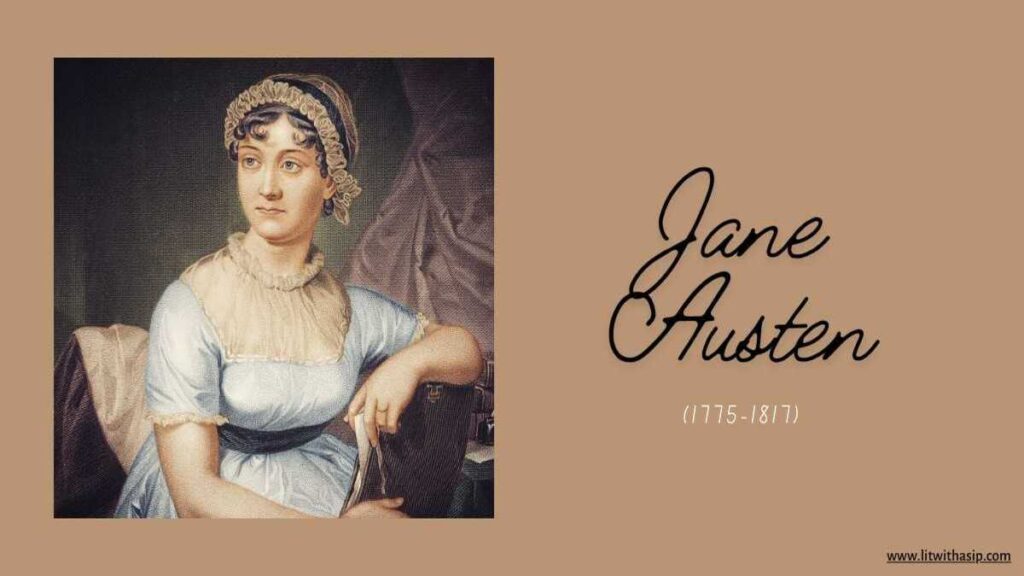The Industrial Revolution of the 18th and 19th centuries is one of the most important events in history and continues to make an impact on our lives to date. Highly transformative, it marked a transition to new manufacturing processes. This period saw profound changes in technology, economy, and society and was an era of marvelous inventions. Many historians recognize it as the first step of humankind towards modernization, global progress, upliftment of living standards, international trade, and connecting nations around the globe. However, the portrayal of this revolution in historical narratives is nuanced, reflecting both its remarkable achievements and its considerable drawbacks.
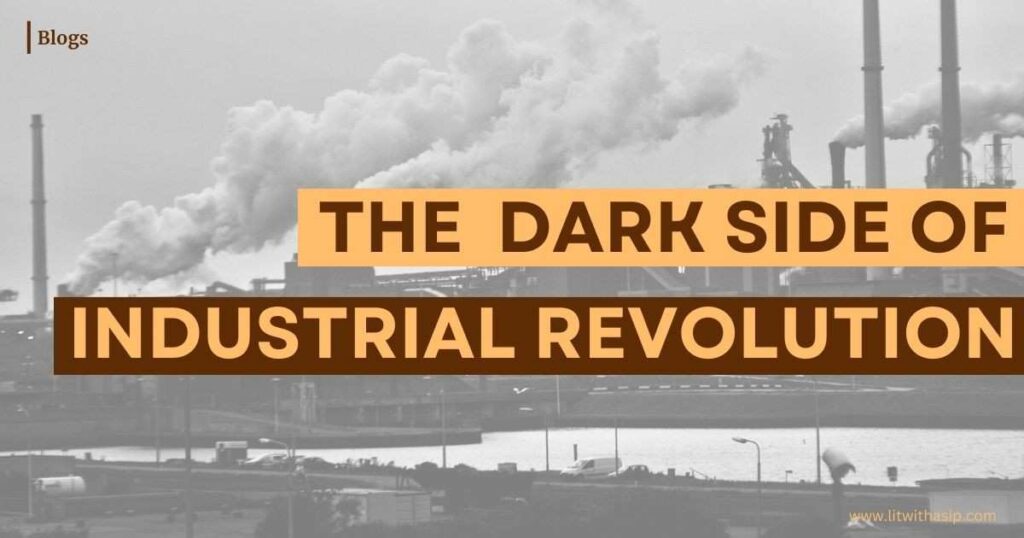
This blog addresses various perspectives concerning the Industrial Revolution, each of which adds up to prove how it was indeed a big failure for humanity.
Smokestacks of Progress
During the Industrial Revolution, immense pollution and environmental devastation emerged as factories spewed vast amounts of smoke and soot into the air. Untreated industrial waste was dumped into rivers, severely contaminating water supplies. This period marked the beginning of large-scale environmental degradation, leading to significant health problems and the transformation of natural landscapes, setting a precedent for modern environmental challenges.
The onset of climate change can be traced back to the 1800s, with industrial-era warming affecting both oceans and continents and setting the stage for future climate challenges. Air pollution, particularly from coal burning, led to significantly higher death rates, especially in industrial areas. Historians note that unregulated coal burning in Britain’s industrial cities produced emissions of black smoke up to 50 times higher than today. The rampant burning of fossil fuels released vast amounts of carbon into the atmosphere, severely deteriorating air quality and making it hazardous to breathe.
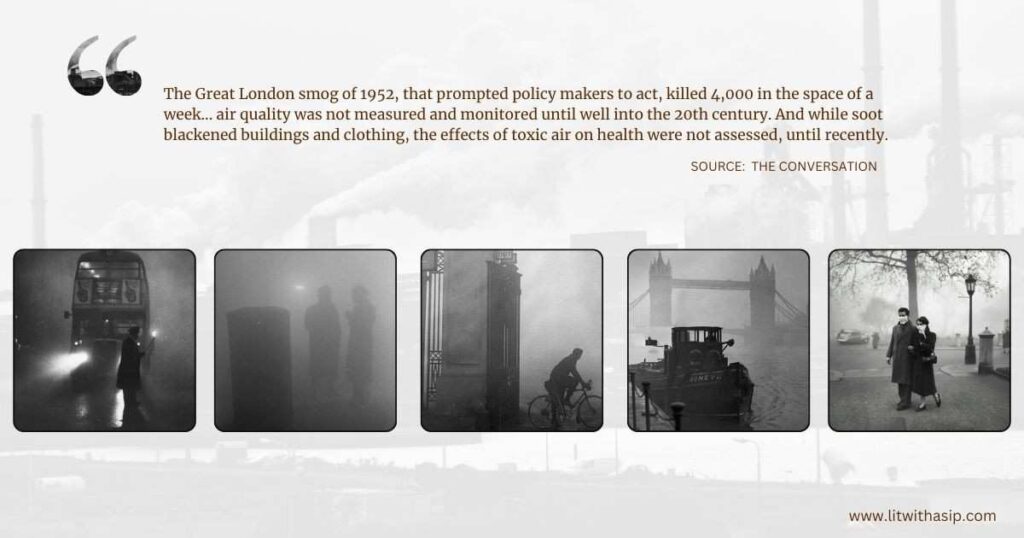
Romantic writers played a crucial role in responding to this devastation by championing nature and critiquing industrialization. They emphasized the beauty and spiritual value of the natural world, as seen in works by poets like William Wordsworth and Samuel Taylor Coleridge, who celebrated rural landscapes and lamented the environmental degradation caused by industrial progress. Their writings inspired a sense of environmental awareness and advocated for a return to nature, influencing early conservationist ideas and leading to the introduction of the Romantic Era.
Also Read: All You Need To Know About The Romantic Age (Late 18th to Mid 19th Century)
Voices Forgotten: Exploitation and Inequality
Various marginalized groups and colonies bore the brunt of environmental degradation and social upheaval, their voices largely forgotten in mainstream historical narratives. The rapid industrialization led to overcrowded cities with poor living conditions. Workers, including children, faced long hours in dangerous environments with little to no labor rights. Diseases like cholera and tuberculosis were rampant due to unsanitary conditions. Historians denote that the life expectancy for laborers fell to around 17 years in England in the 1830s, compared to 38 years in rural areas.
Women were doubly marginalized during the revolution. Positioned as secondary within the social hierarchy, they often endured harsh working conditions in textile mills and factories, where they were paid significantly less than their male counterparts. Laura L. Frader, the author of ‘The Industrial Revolution: A History in Documents’, highlights that factory owners frequently paid women only half the wages that men received for identical work. Women’s labor was crucial to industrial output but largely unrecognized. For instance, in Lancashire’s cotton mills, women accounted for about 50% of the workforce by the mid-19th century, working up to 14 hours a day.
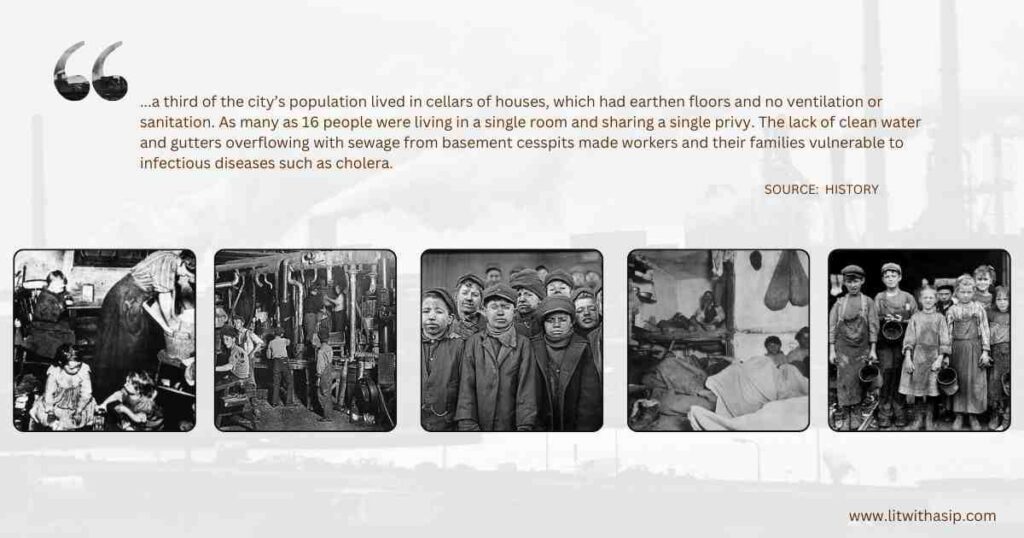
Child labor was prevalent during the revolution, with children as young as five working in mines and factories under grueling conditions. They performed physically demanding tasks for long hours with minimal breaks, facing severe health risks such as respiratory illnesses, physical deformities, and accidents. In mines, children hauled heavy coal carts and worked in poorly ventilated tunnels, while in factories, they operated machinery and cleaned equipment, often leading to serious injuries. The lack of protective regulations led to widespread exploitation, with child laborers receiving extremely low wages.
Literature emerged as a powerful tool for social change, giving rise to children’s literature. Authors like Charles Dickens highlighted the plight of child workers in novels such as “Oliver Twist” and “David Copperfield,” stirring public empathy and fueling reform movements. Concurrently, didactic children’s books educated young readers about moral values and the importance of education over labor. This literary movement played a crucial role in advocating for children’s rights, ultimately contributing to the establishment of child labor laws and improved working conditions. The Factory Act of 1833 was introduced in Britain to regulate child labor, yet many children still worked long hours under perilous conditions.
The wealth gap between various social classes only widened and cemented social hierarchies. Chances for any social mobility were scarce. The profits from industrial enterprises concentrated in the hands of a small elite, creating a distinct class of wealthy industrialists and capitalists.
Lost Traditions and Slavery
Some of the most impacted were the British colonies. For instance, India’s traditional handloom industry was devastated by the influx of cheap machine-made textiles from Britain. Colonies across Africa were heavily exploited for their natural resources, such as rubber, gold, and diamonds. Regions like Indonesia, under Dutch control, and the Philippines, under Spanish and later American rule, saw extensive exploitation of their agricultural and mineral resources.
The revolution precipitated a significant loss of traditional economies, cultures, and ethnic identities across impacted regions. As production in large quantities and standardization became prevalent, artisanal craftsmanship declined sharply, replaced by mechanized methods that prioritized efficiency and uniformity over uniqueness and local craftsmanship. This shift towards industrial methods not only eroded traditional skills and practices but also homogenized cultural expressions as goods became standardized for mass markets. Communities that once thrived on local craftsmanship and diverse cultural practices found themselves marginalized as global trade networks and industrial economies favored larger-scale production and international commerce.
The demand for labor in industrialized sectors fueled the transatlantic slave trade and other forms of forced labor, contributing to the exploitation and displacement of millions of individuals from their homelands and cultures. For instance, the transatlantic slave trade and colonialism specifically targeted Africans due to various factors, including the perceived availability of labor from West Africa, existing systems of servitude in some African societies, and racist ideologies that justified the enslavement of Africans based on notions of racial inferiority.
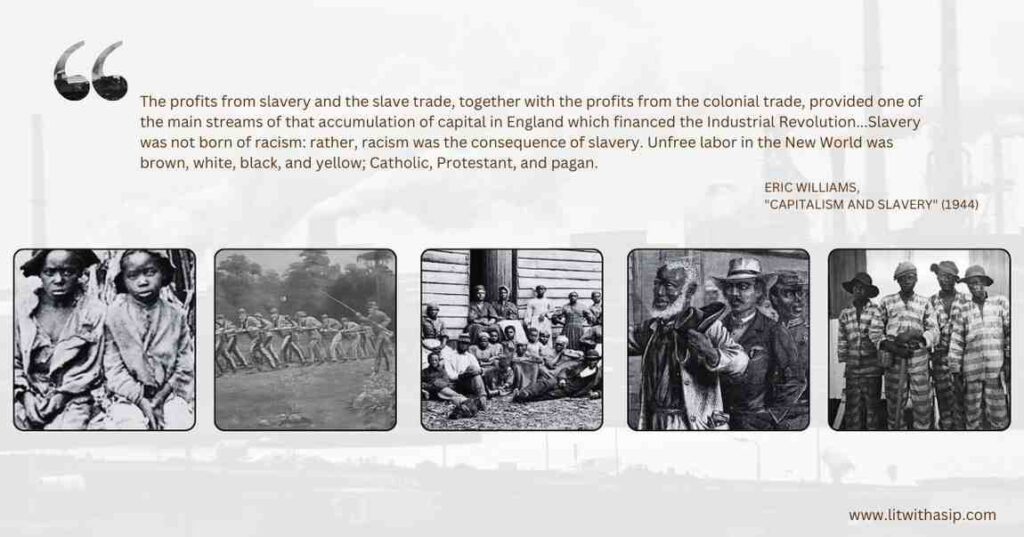
The rise of Multinational Companies (MNCs) was a significant post-industrial revolution phenomenon. These companies capitalized on the industrial advancements and global trade networks established during the revolution, expanding their operations across continents to take advantage of cheaper labor and lower wage rates in colonies. This economic strategy allowed MNCs to produce goods more competitively, tapping into the abundant labor resources available in colonial territories.
Machinery of Oppression
The revolution transformed economies and societies, leading to increased control by governments and corporations. As industries expanded, the need for regulation and infrastructure grew, leading governments to establish laws and policies to manage industrial activities, labor, and urbanization. Powerful corporations emerged, amassing significant economic influence and shaping markets and labor practices, often with government support. This synergy between industrial capitalism and state power facilitated centralized authority and control over resources and populations.
Even though it turned out to be very impactful later, the pace of industrial change was slower than often imagined. The machinery technology was neither inexpensive nor easily adopted. For instance, Steam Engine is often debated as a failure or success in the pages of history. While factories initially used Newcomen’s design (1712), Watt’s improved steam engine (1781) was slow to gain acceptance due to the significant capital already invested in the earlier model and tight budgets that hindered purchasing new, more efficient models. The steam engine eventually found a better competitor in the form of the internal combustion engine, which was developed in the late 19th century.
One of the most important features of this time included the concept of Mass Production, standardized and large production of goods. Pioneered by the car manufacturer- Henry Ford, mass production took a different shape when he sped up the manufacturing process by introducing the assembly line. Stressed by the pressure of work and that too at the same wage rate, workers quit in large numbers initially. Ford, in return, doubled the wages, and increased the pace of work, defining it as the ‘best cost-cutting decision’. Car production in the United States rose from 2 million in 1919 to over 5 million in 1929.
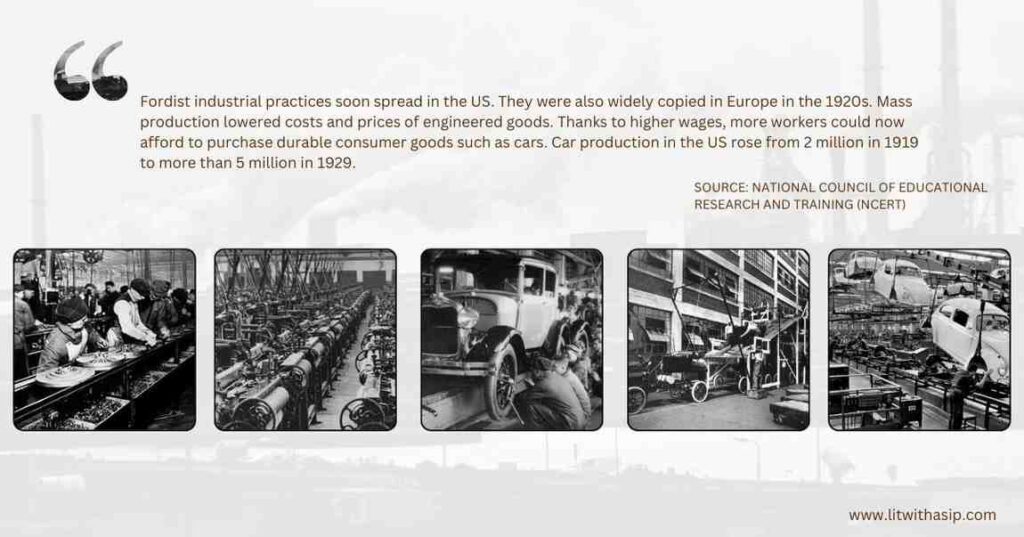
Also Read: Remembering the Industrial Revolution And Its Inventions
In the United States in the 1920s, the demand for machinery (like washing machines, refrigerators, cars, radios, etc.) only rose with time as people were encouraged to buy these goods through ‘hire purchase’, or a method of repaying in installments. This export of capital went beyond the confinement of domestic loans and spread to other nations too, making the US the biggest overseas lender. Soon enough, the world was hit by the Great Depression. Loan repayments to the US were delayed, and factors like doubling import duties and falling agricultural prices compounded the crisis. These issues led to the collapse of the US banking system, triggering a global economic downturn.
Mechanization also meant that workers were deprived of their jobs. In colonies like India, where handicrafts were the most prevalent, constant competition began between mechanized and non-mechanized work. Inventions like Spinning wheels ate up a lot of employment opportunities, making the lives of people miserable. The British colonial policy favored the import of industrial goods from Britain, which undercut local handicraft industries. Traditional weavers and artisans faced severe economic hardship as their markets dwindled.
However, hand-woven clothes and artisanal products retained their appeal among the affluent for their quality. Machine-made goods were cheaper and were bought by the general populace and lower economic classes. This created a dual market.
Dark Side of Innovation
While innovations have propelled societies forward, they have also birthed serious ethical dilemmas. For instance, advancements in weaponry and surveillance technologies have transformed warfare and raised significant moral questions about their use and impact on civilian populations. With its mechanized warfare and mass production of arms, the revolution laid the groundwork for the devastating conflicts of the 20th century, notably the World Wars.

Moreover, the rise of surveillance technologies in recent decades has sparked debates about privacy rights, government surveillance, and the potential for abuse of power. Innovations in surveillance have enabled unprecedented monitoring and control of populations, raising concerns about civil liberties and democratic values. To exemplify this, we can understand Edward Snowden‘s whistleblowing in 2013 that brought global attention to the extensive surveillance practices conducted by governments, particularly the United States’ National Security Agency (NSA).
In conclusion, while the Industrial Revolution was undeniably pivotal in history and laid the foundation for the modern world, it is necessary to acknowledge the profound and often devastating costs incurred at the ground level. The blind pursuit of industrial progress came at the expense of widespread worker exploitation, deplorable living conditions, environmental degradation, and deepening social inequalities. These harsh realities highlight a stark contrast between the era’s celebrated advancements and the human and ecological toll they exacted. This is why this revolution serves as a reminder of the need for a more humane and equitable approach to progress, one that values human and environmental well-being.

Jennis Jacob, a passionate literary enthusiast in her 20s, is a writer and poet. With eight years of experience in literature, she is currently a master in English and finds inspiration in Womanist, American, and Indian Partition Literatures. Her works have appeared in anthologies such as ‘Carved Words Of Creative Minds’ and ‘100 Splendid Voices,’ and she is working on upcoming books. Through LitWithASip, she aims to ignite a love for literature and empower individuals to embrace their true selves.

